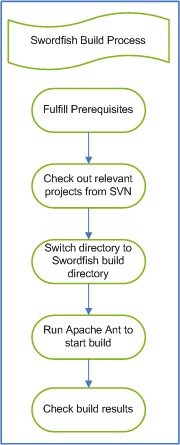Notice: this Wiki will be going read only early in 2024 and edits will no longer be possible. Please see: https://gitlab.eclipse.org/eclipsefdn/helpdesk/-/wikis/Wiki-shutdown-plan for the plan.
Difference between revisions of "Swordfish Documentation: Creating Headless Build"
(→Running a Third-Party Build) |
|||
| Line 77: | Line 77: | ||
</li> | </li> | ||
<li>Switch to the directory <tt><Swordfish project root directory>/org.eclipse.swordfish.build</tt></li> | <li>Switch to the directory <tt><Swordfish project root directory>/org.eclipse.swordfish.build</tt></li> | ||
| − | <li>Start the <tt>ant</tt> script to run the build with the parameter, <tt> | + | <li>Start the <tt>ant</tt> script to run the build with the parameter, <tt>third.parties</tt>.</li> |
<li>Check the build results in <tt>org.eclipse.swordfish.build/target-third-parties</tt>.</li><br> | <li>Check the build results in <tt>org.eclipse.swordfish.build/target-third-parties</tt>.</li><br> | ||
</ol> | </ol> | ||
Revision as of 06:53, 2 October 2009
Contents
Creating and Running a Headless Build
This section contains instructions on creating a headless build.
Prerequisites
The following prerequisites must be met before you start creating the build. You must have the latest version of Eclipse, Apache Ant & Subversion installed. Detailed instructions are provided here.
Eclipse
- Install Eclipse SDK.
- Install the subversion PDE build plugin.
You can find it here: SVN PDE Build
NOTE: When making a remote build you need to fetch projects from SVN.
- Download the zip file, org.eclipse.pde.build.svn-n.n.nRCn.zip.
- Unzip the file and extract the contents of the features folder,( org.eclipse.releng.basebuilder/features) and the plugins (org.eclipse.releng.basebuilder.plugin)folder into the corresponding features and plugins folder in your Eclipse installation directory.
Eclipse Test Framework
Download Eclipse Testing Framework package. You will need it in order to run integration tests which are part of the headless build.
Eclipse Testing Framework for Eclipse Galileo can be downloaded from here:
Eclipse Testing Framework
Ant
Install the latest Ant build (currently, the version available is 1.7) and include it into your path.
You can find the latest version here: Apache Ant
SVN
Install the latest version of the SVN client (currently, the version available is 1.6.2).
You can find the latest version here: Subversion
About the Build Process
The build process is divided into two main stages. This is done for performance reasons. The first stage involves the following steps:
- Generate the third-party bundles
- Create an update site and store these bundles there.
- Upload the update site into the Swordfish download area.
NOTE: The last step only needs to be done when changes occur.
For example, when you create a new bundle, remove an obsolete bundle or create a new bundle version.
The second stage involves the following steps:
- Create the Swordfish site.
- Create the corresponding Swordfish update site.
You also need to ensure that your SVN client is enabled to access the Swordfish Repository via your proxy.
Running a Third-Party Build
This is the first stage of the Swordfish build process, that is, creating the third-party builds.
First Stage
To successfully create and run the third-party build:
- Check out the following projects from the Swordfish SVN + version-to check-out, for example, trunk.
- org.eclipse.swordfish.build
- org.eclipse.swordfish.bundles
- org.eclipse.swordfish.third-parties/org.eclipse.swordfish.third-parties.site
- Edit the `<used_directory>/org.eclipse.swordfish.build/etc/launcher.properties to set these two properties:
- eclipseLocation=[root directory of Eclipse installation, for example, c:/Program Files/eclipse]
- pdeBuildPluginVersion=[version number of the PDE plugin. The PDE plugin can be found in Eclipse in the folder plugins]
- Switch to the directory <Swordfish project root directory>/org.eclipse.swordfish.build
- Start the ant script to run the build with the parameter, third.parties.
- Check the build results in org.eclipse.swordfish.build/target-third-parties.
NOTE: The build results consist of the update site for Swordfish third-parties. It is located in the site sub-directory.
Creating and Running the Swordfish Headless Build
This is the second stage of the Swordfish build process, that is, creating the Swordfish build and update site.
Second Stage
To successfully create and run the Swordfish build:
- Check out the following projects from the Swordfish SVN
- org.eclipse.swordfish.build
- org.eclipse.swordfish.bundles
- org.eclipse.swordfish.third-parties.site
- Switch to the directory <Swordfish project root directory>/org.eclipse.swordfish.build
- Edit the `<used_directory>/org.eclipse.swordfish.build/etc/launcher.properties to set these four properties:
- eclipseLocation=[root directory of Eclipse installation, for example, c:/Program Files/eclipse]
- pdeBuildPluginVersion=[version number of the PDE plugin. The PDE plugin can be found in Eclipse in the folder plugins]
- eclipseTestFrameworkPackage=[location of Eclipse Testing Framework archive, for example, c:/Install/eclipse-test-framework-3.5.zip]
- eclipseTestPluginVersion=[version number of the Eclipse Automated Testing plugin (org.eclipse.test) from test framework. This plugin can be found in <eclipse_testing_framework>\plugins directory]
NOTE: The last two properties are required if you plan to run integration tests during the Swordfish build. By default the tests execution is enabled.
However, you can switch it off by adding to the arguments list a noTest property and setting it to true. For example:ant -DnoTest=true
- Start the ant script to run the build.
- Check the build results:
- Browse to the directory org.eclipse.swordfish.build/target.
- The site sub-directory contains the update site for Swordfish.
Running a Local Build
Before you run a local build the following tasks must first be completed.
- Execute a third-party build.
- Check the build results.
- If not already done, check out all projects from the Swordfish SVN + version-to check-out, for example, trunk.
To execute the local build:
- Switch to the directory <Swordfish project root directory>/org.eclipse.swordfish.build and execute the ant build script with parameter:
ant -Dlocal=true
You can also specify this property in your launcher.properties file.
Check Proxy Settings
If you want to run the build scripts within a firewall, ensure that you enable the proxy settings.
For example, add the -autoproxy parameter when you run the ant scripts.
NOTE: The ant scripts use your default system proxy settings.
You also need to ensure that your SVN client is enabled to access the Swordfish Repository via your proxy.

